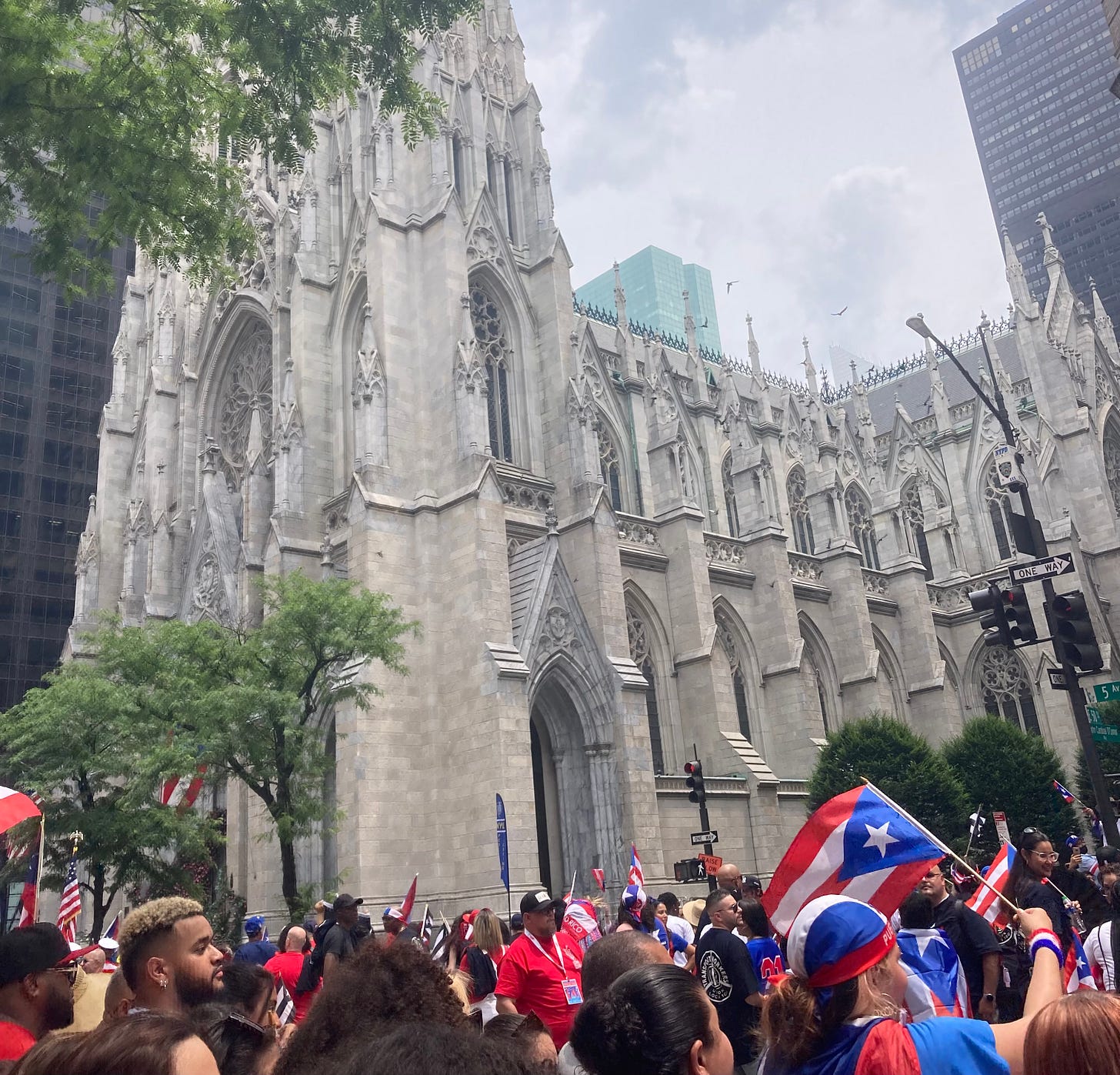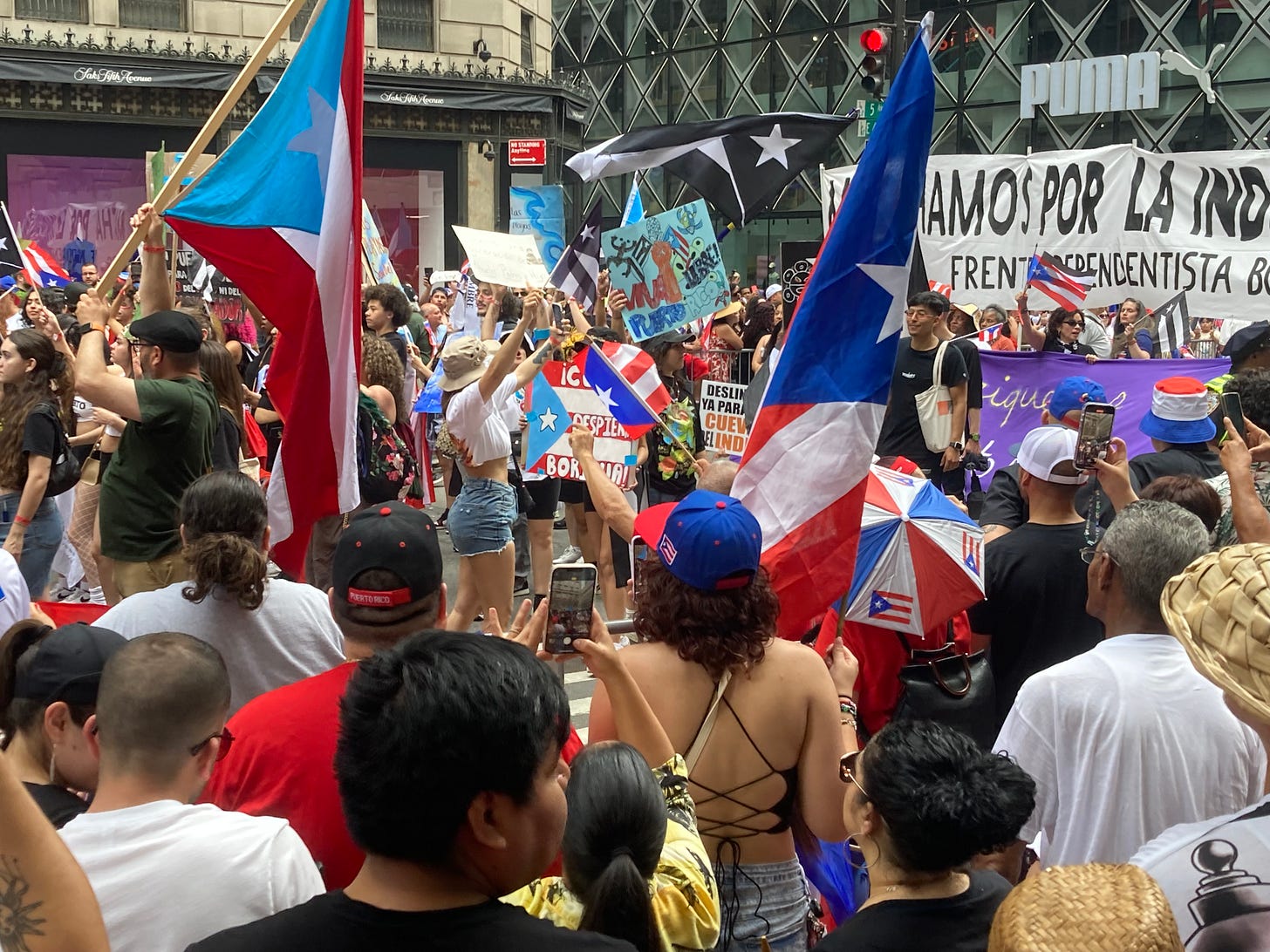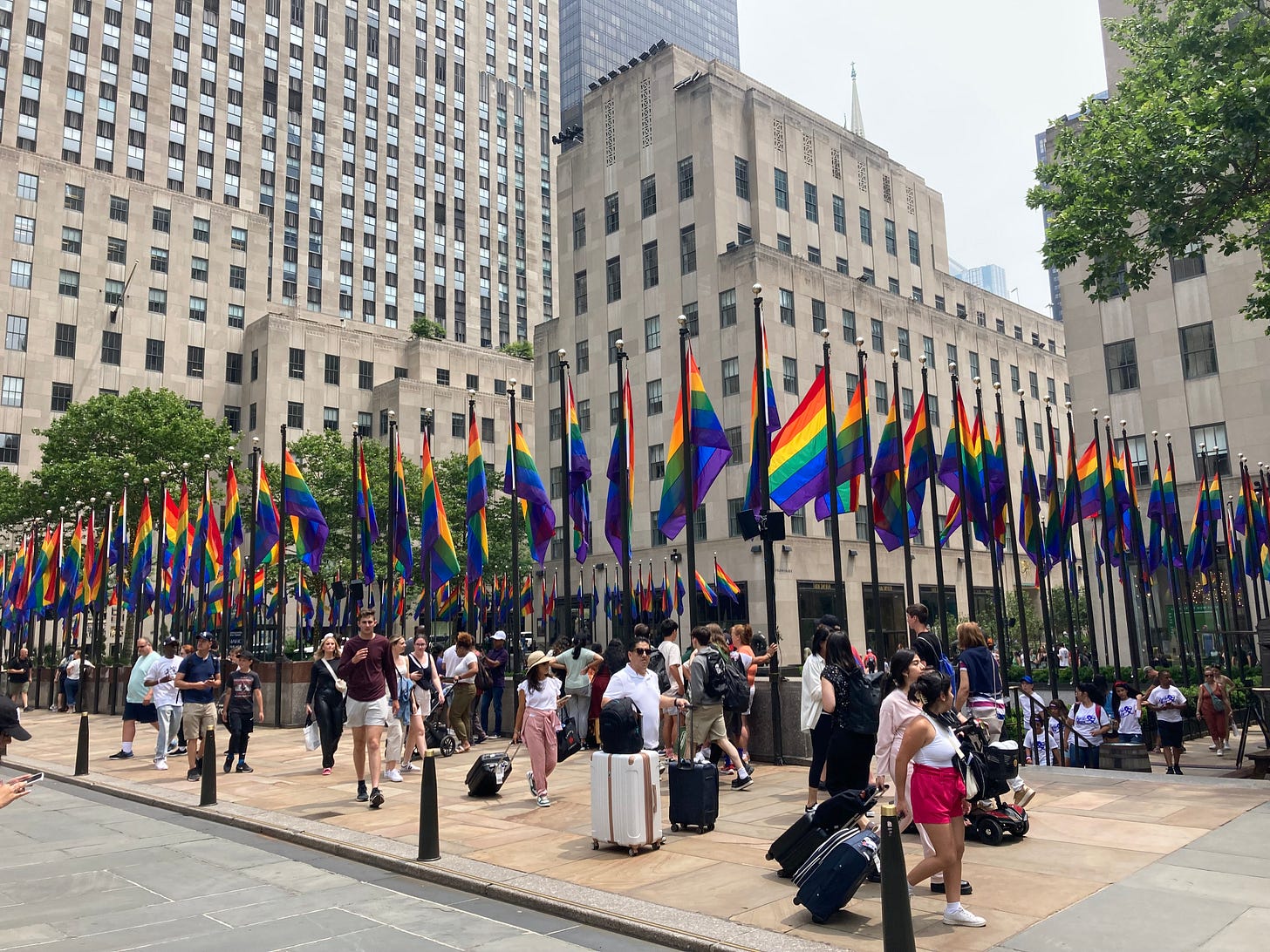Parading our identities
plus the Anglo/ethnic paradigm in Hallmark movies
if you’re interested in preordering a copy of cracks in pomo: the zine or in making a financial contribution, email stephenadubato at gmail dot com
During the month of June, a variety of parades and processions take place in the NYC area, including the Puerto Rican up 5th Ave, Pride down 5th Ave, Corpus Christi (various around the city), and Portuguese in Newark. These public spectacles are lasting vestiges of what Charles Taylor calls times of “anti-structure” or “the festive” (which I have written extensively about here and here). These moments serve as a “release valve,” where people can escape the monotony of everyday life and step inside an enchanted realm. The experience is deeply cathartic and fosters social cohesion. These parades (especially the Corpus Christi procession) serve a liturgical function, both shaping and expressing spiritual convictions about who we are and our relationship with the broader cosmos.
I’ve been thinking about the implications that each parade has for the way we construe identity. In our current cultural moment where poststructuralism has a monopoly on our discourse and a globalist technocratic paradigm informs our sense of reality, we tend to think of identity as an abstraction—a category to be checked off, uprooted from the given…a performance divorced from our lived experience, a projection of our tastes and whims rather than emerging organically from the circumstances handed to us in life. Whether in the name of religion, ethnicity, or sexuality, many attend parades as a way to publicly perform our identity, to signal to other how we define ourselves.
And yet, the actual experience of attending one of these parades transcends the poststructuralist paradigm—precisely because it is an experience. It is communal, and often is the fruit of a legacy, a tradition carried out and developed over time. Though we may tell ourselves that we go to the parade to celebrate our self-determined identities, what really draws us is the fact the for a moment in time, we experience our identities as something that transcends our self-referential categories. We are participating in something much bigger than ourselves…we experience a rush that we could not generate for ourselves. Far from being abstract, they are concrete, carnal, and vibrant.
I was provoked by the fact that there were several rainbow/Puerto Rican flags at the Puerto Rican parade, as well as by the fact that as soon as a float started passing by St. Patrick’s Cathedral, they would lower the volume of the music. One DJ even announced that he was turning off the music “out of respect for the church.”
I think there’s something to be said about how the ethnic paradigm can negotiate a space where a complex web of identities are integrated in a nuanced way…in a way that avoids the ideological and self-referential pitfalls that the others are more prone to. For many (though not for all), walking behind the Eucharist in public is a way of making an ideological statement, as is waving around a rainbow flag (thought perhaps not in the same way). Ethnicity (though it can quickly veer toward nationalism/supremacy) creates a solid foundation, a fertile space for integrating the various parts of one’s identity, situating it within a history that precedes oneself, precisely because ethnicity is more explicitly “given”…in the sense that you can’t choose it…in a way that one’s religious beliefs and sexual preferences are not.
******************************
On the ethnicity note…I cringed when my mother told me she was going to watch the new “Greek” Hallmark movie. After watching it, my hunch was right: it was yet another ridiculous Hallmark movie full of predictable plot lines, crappy writing, and even worse acting. Yet I couldn’t deny that it was a valuable specimen of “cultural anthropology.” It carries on in the tradition of stories that juxtapose the culture clash between assimilated WASPs and “ethnic” people.
These types of stories usually show Anglo (or assimilated) American families being forced to confront the distinct lifestyles and worldviews of ethnic (often immigrant) families due to the marriage of their children. The Anglos are shocked by the earthiness, brashness, and regard for tradition of the ethnics, while the ethnics are shocked by the genteel, repressed, and rootless sensibilities of the Anglos. “These people,” says Gus Portokalos in My Big Fat Greek Wedding, “are dry…like a piece of toast. I try to put a little marmalade….oh no! They don’t want marmalade!”
I often refer to the works of Camille Paglia and Michael Novak when writing about the distinct sensibilities of the two groups. They both capture well the deeper psychological, metaphysical, aesthetic, and sociological implications of these clashes. Charles Taylor also complements their work, explaining the historical development of the “disenchanted”, rationalistic, “respectable” worldview of assimilated Anglos, who are building on a mix of Enlightenment and Protestant assumptions about truth and human nature, whereas the ethnics usually inhabit a more “enchanted” or “incarnated” worldview that allows space for tension and complexity, relying on a pagan and Catholic/Orthodox (or Jewish or Muslim) view.
[I explore this in my essay on Rick Caruso, as well as in my articles on Columbus Day, Ramy, and the Netflix film You People. I also discuss this in depth with Chloe Valdary in a recent episode on her podcast The Heart Speaks.]
Though not even coming close to the quality of the others in this category (My Big Fat Greek Wedding, Good Will Hunting, The Light in the Piazza, Bend It Like Beckham, Ramy), the Hallmark film highlights the psychological dimension of this clash, and offers some practical insights for people in the midst of such circumstances. Unlike in My Big Fat Greek Wedding, the Anglo fiancée in this movie is not a go with the flow kind of gal. Instead, her blandness and individualism makes it incredibly difficult for her to adjust to the culture shock.
In sum, the main drama revolves around the Anglo bride’s disregard for tradition, her individualism, lack of flexibility, and need to maintain clear and rigid boundaries vs. the Greek mother-in-law’s exaltation of tradition, invasive and overbearing way of “loving” her family members, and emotional manipulation. The bride is repressed and resentful, while the mother is neurotic and controlling.
The denouement was predictably sentimental and overly simplistic, and the film fails to tap into the deeper metaphysical origins of such conflicts. But for a Hallmark film it did a decent job depicting the good and bad sides of each “side,” and offered a healthy model for reasonable give and take…a potential bandaid until a family is ready to deal with bigger questions about their ideological convictions.
$upport CracksInPomo by choosing a paid subscription of this page, or by offering a donation through Anchor. Check out my podcast on Anchor and YouTube and follow me on Instagram and Twitter.
photo taken in lower Manhattan.







Would be curious to know how far the "performing an identity" factor goes in the experience of those watching the parade — do the spectators consider themselves "part of" the paraded identity in any meaningful way? Are they acting as mere spectators / observers, similar to how foreign observers will monitor elections or wars? Or perhaps there is a continuum from utterly disinterested, what's-going-on-on-my-street voyeurism to "I stand in full solidarity and alliance"?